
Paranotoreas is a genus of moths in the family Geometridae. It was described by Robin C. Craw in 1986.

Asaphodes aegrota is a species of moth in the family Geometridae. It was first described by Arthur Gardiner Butler in 1879 as Selidosema aegrota. It is endemic to New Zealand and can be found in the North, South and Stewart Islands. This species inhabits open spaces in lowland native forest. The larvae of A. aegrota feed on native herbs and have also been observed feeding of the introduced lawn daisy. The adults are variable in appearance with the markings on both sides of its wings varying in intensity. Some populations also have narrow winged females. Adults are on the wing from November until March.

Aponotoreas anthracias is a moth of the family Geometridae. It is endemic to New Zealand. This species was first described by Edward Meyrick in 1883 under the name Larentia anthracias. Specimens of this species have been collected in the Maungatua ranges, the Remarkables and the Hawkdun Ecological District in Otago. The host plant of this moth is Dracophyllum.
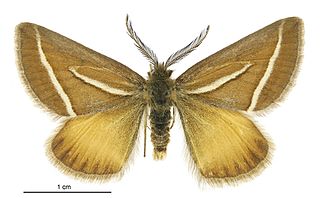
Aponotoreas insignis is a moth of the family Geometridae. It is endemic to New Zealand.

Arctesthes catapyrrha is a moth of the family Geometridae. It is endemic to New Zealand.

Asaphodes beata is a species of moth in the family Geometridae. It is endemic to New Zealand and is a relatively common species that can be found throughout the country in native forest or scrub habitat. It can be distinguished from its close relative Asaphodes adonis by the colour of its hind wings. The larvae of this species feeds on watercress but tends to be inactive during the day. If threatened it will mimic a twig dropping to the ground. The adult moths are on the wing from October to March and are said to be attracted to white rātā. The white markings on the forewing of the adults are variable in appearance.

Asaphodes chlorocapna is a species of moth in the family Geometridae. This species is endemic to New Zealand and can only be found in the Chatham Islands. The larvae of this species consume the leaves of Muehlenbeckia plants. Adults are on the wing in January. This species is classified as "At Risk, Relict'" by the Department of Conservation.
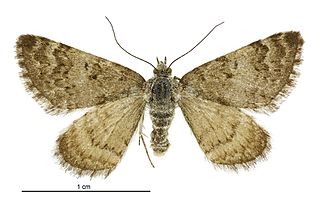
Paranotoreas fulva is a species of moth in the family Geometridae. This species is endemic to New Zealand. It is classified as "At Risk, Relict" by the Department of Conservation.

Paranotoreas brephosata is a species of moth in the family Geometridae. This species is endemic to New Zealand.

Asaphodes omichlias is a moth in the family Geometridae. It is endemic to New Zealand and has been observed in both the North and South Islands. This species inhabits rocky, open country in high mountains. Adults are on the wing in January and February. The appearance of the adult of this species is variable with some specimens having a paler and more grey appearance than the more usual brown appearance.
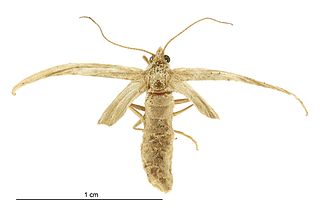
Asaphodes oraria is a species of moth in the family Geometridae. This species is endemic to New Zealand and has been observed in the southern South Island and on Stewart Island / Rakiura. The male is pale yellow coloured and the female has severely reduced wings and is flightless. The habitat of this species is tussock grasslands on coastal sand dunes and in the mountains at elevations of approximately 4,000ft. The larvae have adapted to feeding on exotic lawn daisy species in the genus Bellis. The adults of this species are on the wing from November to April.

Asaphodes sericodes is a moth in the family Geometridae. It is endemic to New Zealand and has been observed in the southern parts of the South Island. This species inhabits open tussock grasslands in subalpine scrub or wetlands. The female of the species is likely semi-apterous and is flightless. The adult males are on the wing in January.

Helastia corcularia is a moth of the family Geometridae. This species is endemic to New Zealand. It was first described by Achille Guenée in 1868 and named Larentia corcularia.
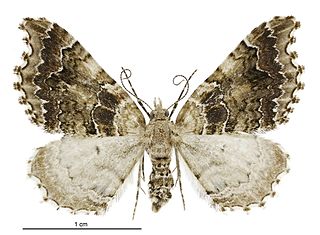
Helastia cymozeucta is a moth of the family Geometridae. This species is endemic to New Zealand. It was first described by Edward Meyrick in 1913 and named Xanthorhoe cymozeucta.

Helastia farinata is a moth of the family Geometridae. This species is endemic to New Zealand. It was first described by William Warren in 1896 and originally named Xanthorhoe farinata.
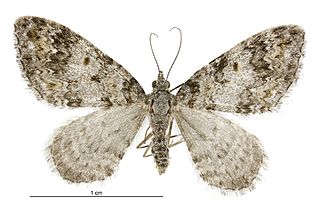
Helastia plumbea is a moth of the family Geometridae. This species is endemic to New Zealand. It was first described by Alfred Philpott in 1915 and originally named Xanthorhoe plumbea.

Helastia semisignata is a moth of the family Geometridae. This species is endemic to New Zealand. It was first described by Francis Walker in 1862 and originally named Larentia semisignata.

Helastia triphragma is a moth of the family Geometridae. This species is endemic to New Zealand. It was first described by Edward Meyrick in 1883 and originally named Cidaria triphragma.
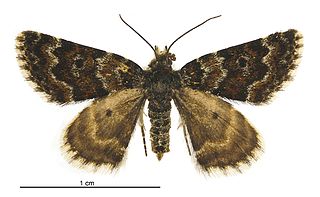
Paranotoreas opipara is a species of moth in the family Geometridae. This species is endemic to New Zealand. This species was first described by Alfred Philpott in 1915 and named Notoreas opipara. In 1986 Robin C. Craw placed this species within the genus Paranotoreas.
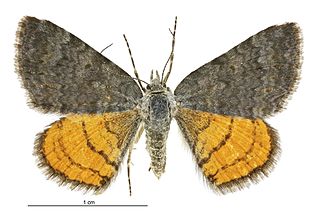
Paranotoreas zopyra is a species of moth in the family Geometridae. This species is endemic to New Zealand. This species was first described by Edward Meyrick in 1883 and named Pasithea zopyra. In 1986 Robin C. Craw placed this species within the genus Paranotoreas.





















